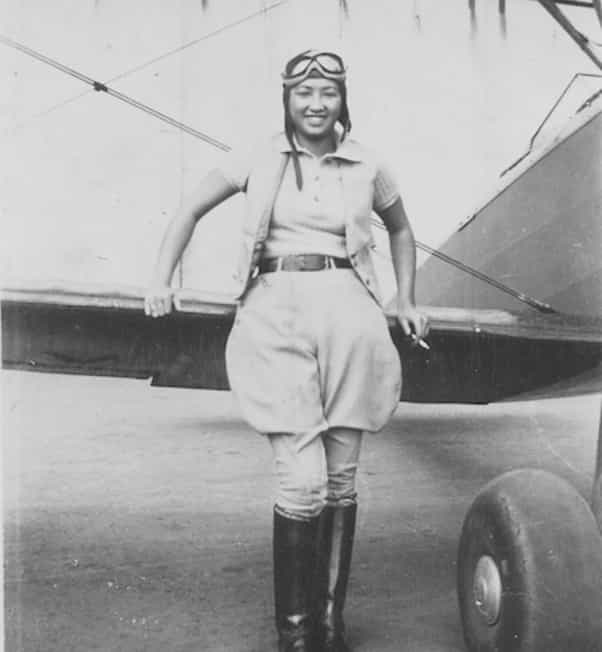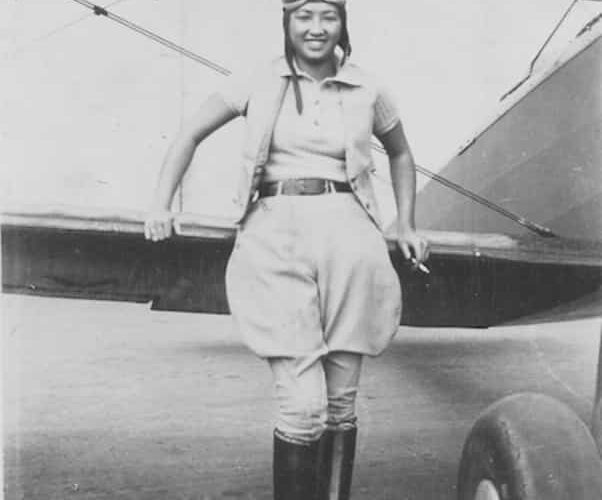Hazel Ying Lee: The First Chinese-American Woman to Fly for the U.S. Military

Hazel Ying Lee was a remarkable woman who made history as the first Chinese-American woman to fly for the United States military. She was part of the Women Airforce Service Pilots (WASP) program during World War II, a group of only 1,074 women who became pilots for the U.S. military in a time when female pilots were rare, and Asian-American women even rarer. Hazel’s story is one of bravery, determination, and a desire to break barriers. She faced many challenges, but she never let them stop her from pursuing her dreams.
Hazel was born in 1912 in Portland, Oregon. Over the years, her story has inspired many people, especially after a picture of her was displayed at the Museum of Chinese in America. Picture book author Julie Leung saw the photo there and felt an instant connection to Hazel.
Julie Leung, who later wrote a book about Hazel titled The Fearless Flights of Hazel Ying Lee, was drawn to Hazel’s expression in the photo. “There was something bold and fearless about her expression and I wanted to know about her,” Leung said. This inspiration led to the creation of the book, which was published in March.
The Early Years of Hazel Ying Lee
Hazel’s journey to becoming a pilot began at the age of 19, when she took her first flight. From that moment, she was hooked on flying. Leung describes how Hazel became obsessed with learning to fly after that first experience. In less than a year, Hazel earned her pilot’s license, a remarkable achievement at a time when very few women, especially Chinese-American women, became pilots.
In the 1930s and 1940s, flying was mostly a male-dominated field. Only a small percentage of pilots were women, and even fewer were Asian-American. Hazel’s determination to become a pilot in the face of these obstacles shows her strength and courage.
Joining the WASP Program
In 1942, Hazel had the chance to pursue her dream when she was accepted into the Women Airforce Service Pilots (WASP) program. This program was created during World War II because many male pilots had gone off to fight overseas, and the military needed more pilots to help with the war effort. The WASP program was designed to give women the opportunity to serve their country by flying planes to the front lines.
Although the women in the WASP program were highly skilled, they were not officially considered military members. Instead, they served as civilians. The pilots in the WASP program did many important tasks, such as flying planes that had just been built, which meant they were often the first to spot any defects in the planes. These women flew many miles, covering a total of 60,000,000 miles during the two years the WASP program was active.
Hazel was one of only 1,074 women to be accepted into the WASP program. During her time in the program, she gained experience flying different types of planes, including fighter jets, which made her one of the most skilled pilots in the group. Leung describes Hazel as an incredible woman who brought energy and personality to everything she did. Hazel was known for writing Chinese nicknames on the tails of her fellow pilots’ planes with lipstick and for her bright, joyful smile, which reflected her vibrant personality.
A Trailblazer for Women and Asian-Americans
Hazel Ying Lee was not just a trailblazer for women in aviation, but also for Chinese-American women. At a time when many people believed that women should not be pilots and that Chinese-Americans could not be true patriots, Hazel proved them wrong. She wanted to do something no other Chinese-American girl had done before, and she did not care that becoming a pilot was considered “unladylike.”
Julie Leung, the author of Hazel’s book, hopes that her story challenges stereotypes about Asian-American women. Many people have the wrong idea that Asian-American women are meek or submissive, but Hazel’s boldness and courage stand in direct contrast to these assumptions. Leung hopes that her book will encourage readers to see Asian-American women in a new light, as strong, independent, and capable individuals.
In addition to challenging stereotypes, Leung hopes her book helps readers rethink what it means to be patriotic. Despite facing racism and discrimination, especially with laws like the Chinese Exclusion Act in place, Hazel was still willing to serve her country. As Leung says, “She still died in service for this country.” This shows that patriotism is not just about where you come from, but about your ideals and your dedication to making the world a better place.
Hazel’s Legacy
Hazel Ying Lee died while serving her country in 1944, when a miscommunication caused her plane to collide with another while landing in Montana. Despite her incredible service and the danger she faced as a pilot, Hazel’s death was met with more challenges. After her death, her family was denied permission to bury her at a cemetery because it was designated for white people only. But Hazel’s family fought back, writing a letter to President Franklin D. Roosevelt, and they succeeded in having her buried in a cemetery in Portland, Oregon, alongside her brother Victor, who had also died serving the country.
Hazel’s contributions did not go unnoticed. In 1977, after years of fighting for recognition, the women in the WASP program were officially granted veteran status and full benefits. Then, in 2010, they were honored with the Congressional Gold Medal, one of the highest honors a civilian can receive in the United States.
Today, Hazel Ying Lee’s legacy lives on. Her portrait is displayed on the Wall of Honor at the Evergreen Aviation & Space Museum, reminding visitors of her bravery and dedication. Her story continues to inspire new generations of women and Asian-Americans to reach for their dreams, no matter how impossible they may seem.
A Powerful Story
Julie Leung’s book about Hazel Ying Lee includes a powerful excerpt that captures the spirit of Hazel’s bravery and determination: “No one could see her eyes, hair, or skin color when Hazel was thousands of feet above. Up here, people were just tiny specks against a vast land. And inside her cockpit, Hazel felt like a dragon chasing down the sun. She leaned into the wind, pushing her plane to go faster. She looked at the horizon, and willed the world to move forward.”
Hazel Ying Lee’s story is one of courage, strength, and resilience. She fought against stereotypes and discrimination, proving that anyone, regardless of gender or race, could achieve greatness. Her work in the WASP program helped the United States win the war, and her legacy continues to inspire people today.
Frequently Asked Questions (FAQ) about Hazel Ying Lee
1. Who was Hazel Ying Lee?
Hazel Ying Lee was the first Chinese-American woman to serve as a pilot in the United States military. She was part of the Women Airforce Service Pilots (WASP) program during World War II, where she flew planes to support the war effort, even though women pilots were rare at the time, and Asian-American women were even less common in aviation.
2. What was the WASP program?
The Women Airforce Service Pilots (WASP) program was created during World War II to train women to fly military planes. The women in the program were civilian pilots, not officially part of the military, but they played a vital role in supporting the war by flying planes to and from the front lines, transporting supplies, and testing new aircraft. Over 1,000 women, including Hazel Ying Lee, served in the program.
3. How did Hazel Ying Lee become a pilot?
Hazel became interested in flying at the age of 19 and earned her pilot’s license in less than a year. This was during a time when very few women, especially Chinese-American women, were becoming pilots. Despite the challenges, she was determined to fly and continued to pursue her passion for aviation.
4. What was Hazel Ying Lee’s role in the military during World War II?
Hazel Ying Lee served as a pilot in the WASP program, where she flew planes to help with the war effort. She was one of the 1,074 women who served in this program, and she flew more than 60 million miles during her service. Her work involved flying planes that were newly built, helping identify manufacturing defects, and flying a variety of aircraft, including fighter jets.
5. What challenges did Hazel Ying Lee face as a Chinese-American woman in aviation?
As a Chinese-American woman, Hazel faced racial and gender-based discrimination. During this time, very few women were pilots, and even fewer were Asian-American. Despite this, Hazel was determined to pursue her dreams, becoming one of the first Chinese-American women to join the WASP program. She showed great courage in the face of these obstacles, proving that she could succeed where others thought it was impossible.
6. How did Hazel Ying Lee’s family fight for recognition after her death?
Hazel Ying Lee tragically died in 1944 while serving her country when her plane collided with another while landing. After her death, her family faced additional discrimination when they were denied permission to bury her at a local cemetery because it was a “whites only” section. They wrote a letter to President Franklin D. Roosevelt, and their efforts succeeded. Hazel was eventually buried at Riverview Cemetery in Portland, Oregon, alongside her brother, Victor, who had also served in the military.
7. What is the legacy of Hazel Ying Lee?
Hazel Ying Lee’s legacy is one of courage, determination, and breaking barriers. She was a trailblazer for both women and Asian-Americans, proving that anyone could achieve greatness despite facing societal challenges. She was posthumously honored with the Congressional Gold Medal in 2010, and her portrait is displayed at the Evergreen Aviation & Space Museum. Her story continues to inspire generations to reach for their dreams.
8. How is Hazel Ying Lee remembered today?
Hazel Ying Lee is remembered for her groundbreaking work as a pilot during World War II and for her trailblazing role as a Chinese-American woman in aviation. Her portrait hangs in the Museum of Chinese in America, and her story is preserved in the book The Fearless Flights of Hazel Ying Lee by Julie Leung. Her contributions to aviation and her service to her country are honored and celebrated, ensuring that her legacy lives on.
9. What is The Fearless Flights of Hazel Ying Lee about?
The Fearless Flights of Hazel Ying Lee is a picture book written by Julie Leung and illustrated by Julie Kwon. The book tells the story of Hazel Ying Lee’s life, her journey to becoming a pilot, and her service in the WASP program during World War II. It highlights her bravery, determination, and the challenges she overcame to achieve her dreams, providing young readers with an inspiring role model.
10. Why is Hazel Ying Lee important in American history?
Hazel Ying Lee is important because she was one of the first women to break into a male-dominated field and became the first Chinese-American woman to serve as a pilot in the U.S. military. Her story challenges stereotypes about Asian-American women and demonstrates the power of perseverance in overcoming discrimination and barriers. She made a significant contribution to the war effort, and her legacy continues to inspire people today.

